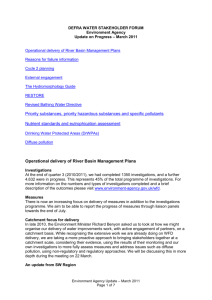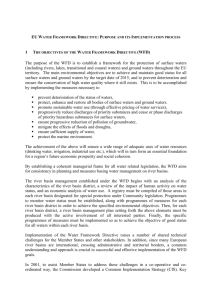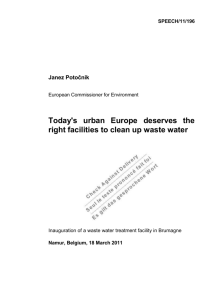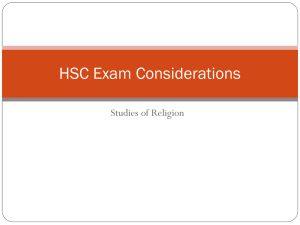EA Update
advertisement
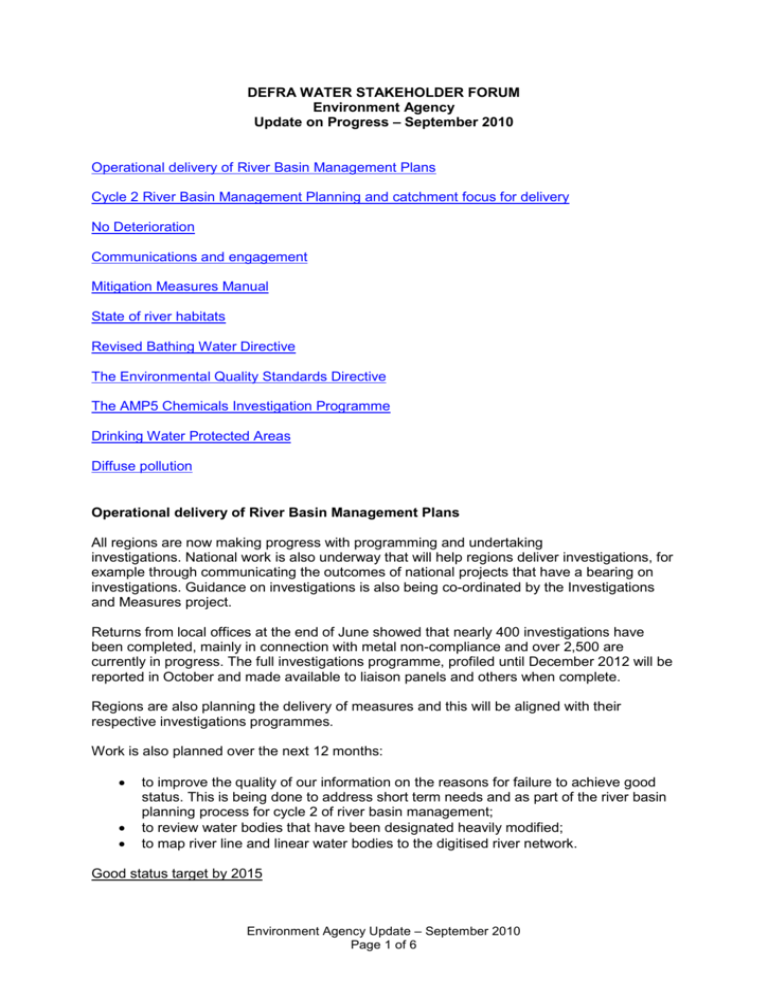
DEFRA WATER STAKEHOLDER FORUM Environment Agency Update on Progress – September 2010 Operational delivery of River Basin Management Plans Cycle 2 River Basin Management Planning and catchment focus for delivery No Deterioration Communications and engagement Mitigation Measures Manual State of river habitats Revised Bathing Water Directive The Environmental Quality Standards Directive The AMP5 Chemicals Investigation Programme Drinking Water Protected Areas Diffuse pollution Operational delivery of River Basin Management Plans All regions are now making progress with programming and undertaking investigations. National work is also underway that will help regions deliver investigations, for example through communicating the outcomes of national projects that have a bearing on investigations. Guidance on investigations is also being co-ordinated by the Investigations and Measures project. Returns from local offices at the end of June showed that nearly 400 investigations have been completed, mainly in connection with metal non-compliance and over 2,500 are currently in progress. The full investigations programme, profiled until December 2012 will be reported in October and made available to liaison panels and others when complete. Regions are also planning the delivery of measures and this will be aligned with their respective investigations programmes. Work is also planned over the next 12 months: to improve the quality of our information on the reasons for failure to achieve good status. This is being done to address short term needs and as part of the river basin planning process for cycle 2 of river basin management; to review water bodies that have been designated heavily modified; to map river line and linear water bodies to the digitised river network. Good status target by 2015 Environment Agency Update – September 2010 Page 1 of 6 In the River Basin Management Plans the Environment Agency committed to an additional 2% more water bodies reaching good status, than will be achieved through the measures contained within the plans,, in order to set a stretching target for delivery. This is a national target and has been factored into the overall achievement target which is now 34% for all water bodies across England and Wales to reach good status by 2015. We are looking to other delivery bodies to join with us to achieve this target and accomplish even more. The achievement of water bodies improving to good status is based on the classification results and therefore will be reported annually. Cycle 2 planning and catchment focus for delivery We have started thinking about our approach for cycle 2 planning. The Environment Agency will need help to ensure the process and decision making is transparent and to maximise the freedom to plan at a catchment level. This will improve environmental outcomes and where necessary provide clear justification for setting alternative objectives. We will improve on the first cycle River Basin Management Plans and an early scoping report will be presented to our WFD Programme Board in October before wider involvement is sought throughout the Autumn. We are developing a destination statement which provides a high level statement of what we are trying to achieve and how. This is underpinned by a series of supporting statements which define the Environment Agency’s approach. We plan to consult liaison panels on the destination statement in October, with a view to finalising it by March 2011. We are also developing an Evidence Plan that will identify the gaps in our understanding and information needed to resolve the remaining challenges and deliver environmental outcomes. We will not be able to fill all the gaps in time for second cycle plans. In consultation with Defra and Welsh Assembly Government we will need to agree where to allocate our resource and how partners can contribute. Through this prioritisation exercise we will identify the priority for action for the second cycle and confirm those issues that may need to wait until the third cycle before significant progress is made. This will allow us to target our effort to maximise delivery of environmental outcomes. No Deterioration Preventing deterioration of status will be a significant challenge in many water bodies across England and Wales, particularly in areas of economic and demographic growth. The no deterioration baseline for each water body is the current status that is reported in the River Basin Management Plans published in December 2009, subject to any minor errors that might need correction. This baseline will be next revised when Ministers approve the first update of the River Basin Management Plans in December 2015. However annual information on compliance will be provided to enable transparent monitoring of progress. The Environment Agency is awaiting confirmation of the no deterioration policy from Defra and the Welsh Assembly Government. Communications and external engagement On 7 September we released a press release on the General Quality Assessment (GQA) results for water quality. The results show that river water quality in England has improved for the 20th consecutive year. Over 70% of rivers are now graded as ‘very good’ or ‘good’ under the GQA. Our press office are continuing to work with newspapers and trade publications to secure further coverage. Environment Agency Update – September 2010 Page 2 of 6 We have communications planned around the WFD classification release in October (date still to be confirmed), the State of River Habitats publications and the Otters survey. Regions continue to look for opportunities to promote our progress with delivering improvements to the water environment. They are also working with a number of external groups to promote and secure action by others. River Basin District Liaison Panels will meet for the second time this year, mostly over September and October. The main focus of these meetings will be to discuss progress with investigations and how they are being programmed and prioritised, and progress with measures both Environment Agency and others. The National Liaison Panel for England meets next on 6 October 2010. The key focus of our national communications activity over the next six months will be to: Take an integrated, strategic and consistent approach to external stakeholder engagement; supporting regions to strengthen local engagement and the commitment to deliver; and developing an engagement strategy for cycle 2 planning. We are in the progress of setting up a cross organisational group to focus on engagement and in due course will be asking external organisations to be involved in this group. Manage our communications around key milestones. These milestones are the WFD classification results in October, the no deterioration guidance and the development and release of our WFD destination statement. On diffuse water pollution we are working with farmers and land managers to continue to raise awareness of diffuse pollution. We have a national communications programme which will be focussing on dairy and livestock sectors and looking specifically at nutrient management. Most of our communications activity is being delivered at a local level depending on pressures and catchment needs. Soils and run-off – the East Devon project provides an example of where we have been working with farmers, contractors and partner organisations over the last 2 years to tackle soil compaction, reduce pollution and maximise yields. Mitigation Measures Manual Up until now there has been no single source of information on the effectiveness, costs and ecological benefits of mitigation measures for flood risk management and land drainage activities. To resolve this issue, a best practice digital manual has been put together. The Water Framework Directive (WFD) Mitigation Measures Online Manual provides details of good practices and outlines what ecological benefits may be expected from implementing the listed measures to all artificial and heavily modified water bodies. The guidance can be used to help reduce the impact on physical habitats of flood risk management, and other important activities, and to allow more water bodies to reach 'good'. The manual can be found at: http://evidence.environment-agency.gov.uk/FCERM/MMM State of river habitats To improve our evidence base we have produced a series of publications called ‘Our River Habitats’. These reports assess the physical state of rivers in England, Wales and the Isle of Man. They will be available on our website later this month at: www.environmentagency.gov.uk Environment Agency Update – September 2010 Page 3 of 6 Revised Bathing Water Directive The revised Directive poses a number of challenges for the Environment Agency, the Department of Environment Food and Rural Affairs (Defra), Local Authorities and Beach Operators. It sets more stringent water quality standards and also puts a stronger emphasis on beach management and public information. The key work area we are currently developing to support our move to the revised Directive is: The development of bathing water profiles for all bathing waters, and a general description based on the profile to be displayed on signage at the bathing water. Development of investigations and improvements to improve water quality at bathing waters. Based on 2010 predictions we currently have 46 bathing waters which will not meet the standards of the rBWD in 2015 without further improvement. Within the revised Bathing Water Directive, the main changes that we will be responsible for implementing, and communicating, include: Changes to the microbiological parameters measured and a reduction in the general parameters currently monitored. A change from measuring compliance using the pass/fail approach to classification based on four classes: poor/sufficient/good/excellent. The requirement for all bathing waters to be classed reach ‘sufficient’ the new minimum standard of the rBWD by 2015. The ability to supply more information so the public can choose where to bathe. The current directive will be repealed in 2015 when the final stages of the revised Bathing Water Directive (2006/7/EC) come into force. Our timelines for delivery are: 1. In 2008 the first list of bathing waters under the revised Bathing Water Directive was created. 2. In 2011 we will publish bathing water profiles for all bathing waters on the web. 3. In 2012 monitoring will begin for a 4 year classification to be in place by 2015. 4. In 2015 we will publish our first classification of bathing waters under the revised Bathing Water Directive. The Environmental Quality Standards Directive (EQS) The Environmental Quality Standards Directive replaces the Dangerous Substances Directive and establishes environmental quality standards for 33 priority and priority hazardous substances. Compliance with these EQS forms the basis of Good Surface Water Chemical Status under the Water Framework Directive. We published Pollution Reduction Plans for these substances in December 2009. Environment Agency Update – September 2010 Page 4 of 6 The EQS Directive sets additional objectives in relation to emissions of priority hazardous substances, concentrations of chemicals in sediment and biota, and requirements for monitoring and reporting. It was transposed into national legislation in August through the updated Ministerial Direction on Typology and Standards. We are currently developing the approaches needed for its full implementation. The EU have produced a short-list of further “candidate” priority substances. We are involved in EQS development for some of these substances. We expect that any new priority substances will be added to the scope of EQS Directive before the second cycle of River Basin Planning. The AMP5 Chemicals Investigation Programme In August, water companies started a programme of investigation to quantify the levels of toxic chemicals - primarily priority substance - present in 160 sewage effluents. This programme will also assess the efficacy and costs of options for reducing levels where they are determined to pose a risk to WFD objectives. Options include end of pipe treatment, restrictions on marketing and use and control of trader consents. This work will inform programmes of measures in the second river basin planning cycle. Drinking Water Protected Areas (DrWPAs) Our risk assessment of surface and groundwater DrWPAs in England and Wales indicated that the main pressures are pesticides, colour and nitrates. These occur largely, but not exclusively, as a result of farming and rural land management practices. A programme of investigations and measures was agreed, which address a range of sectors and utilises a variety of delivery mechanisms from PR09 to the Catchment Sensitive Farming initiative. In the last 12 months, our work on DrWPAs has focussed on producing the information required for the first cycle River Basin Management Plans, establishing the necessary monitoring network and refining risk assessment s . As we move into the implementation phase, we want to embed work on DrWPAs into the business and turn our attention to the development of partnerships and national measures and mechanisms for the second river basin planning cycle. These will include working with OFWAT, Chemical Regulation Directorate, Drinking Water Inspectorate, industry and NGOs to address pressures. Diffuse Pollution The Environment Agency have established a Diffuse Pollution sub-Programme under the Environment Agency WFD Programme to help our approach to diffuse pollution. The Diffuse Pollution Programme Board consists of national and regional Environment Agency staff, and also has representation from Defra and Natural England. The Board has agreed the principles behind a strategic approach to addressing diffuse water pollution that establishes the link between monitoring data, levels/confidence (indicating both impact and source apportionment) and the selection of appropriate ways (mechanisms) to deliver measures. This approach will ensure existing measures such as agri-environment, advice initiatives such as Catchment Sensitive Farming, and regulatory activity are used in a more strategic and complementary way. These principles which are relevant to agricultural and non-agricultural diffuse pollution are now being embedded in guidance to help Environment Agency teams carry out investigations and select appropriate measures. The guidance will help to develop a weight of evidence approach including monitoring data and third party information within a catchment or water body to carry out effective action to achieve WFD objectives. Environment Agency Update – September 2010 Page 5 of 6 We are progressing work on urban diffuse pollution and have projects running to provide a better understanding of mis-connections, contaminated sediments and urban run-off (metals and organic chemicals) through work funded by Defra and in collaboration with the water industry through UKWIR. In response to the NAO report on diffuse pollution, we are ensuring work is in train to take forward the recommendations and we are reviewing the application of better regulation principles in our agricultural activities. Environment Agency Water Framework Directive Programme, Water Quality and Land Quality September 2010 Environment Agency Update – September 2010 Page 6 of 6
